You’d Never Guess What an Acorn Woodpecker Eats
Have you ever wondered why woodpeckers pound so incessantly?
In the case of acorn woodpeckers — gregarious black-and-red birds in California’s oak forests — they’re building an intricate pantry, a massive, well-organized stockpile of thousands of acorns to carry them through the winter.
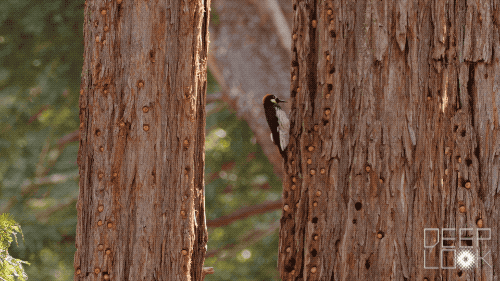
“They’re the only animals that I know of that store their acorns individually in holes in trees,” said biologist Walter Koenig, of the Cornell Lab of Ornithology, who has studied acorn woodpeckers for decades at the University of California’s Hastings Natural History Reservation in Carmel Valley.

Over generations, acorn woodpeckers can drill thousands of small holes into one or several trees close to each other, giving these so-called granaries the appearance of Swiss cheese.
This sets them apart from other birds that drop acorns into already-existing cavities in trees, and animals like squirrels and jays that bury acorns in the ground.
In spring and summer, hikers in the Bay Area commonly see acorn woodpeckers while the birds feed their chicks and care for their granaries. They don’t mind people staring at them and they’re easy to find. They greet each other with loud cries that sound like “waka-waka-waka.”
Marin and Contra Costa counties are good places to spot them. They’re also easy to see in San Jose’s Plaza de Cesar Chavez. Outside California they’re found in Oregon, Arizona, New Mexico and Texas, and south to Colombia.

These avian performers are constantly tapping, drilling and pounding at their granaries.
“They’ll usually have a central granary, maybe two trees that a group is using,” Koenig said. “Those trees are going to be close together.”
Acorn woodpeckers make their granaries in pines, oaks, sycamores, redwoods and even in the palm trees on the Stanford University campus.

Their holes rarely hurt the trees. The birds bore only into the bark, where there’s no sap, or they make their granaries in snags.
“They don’t want sap in the hole because it will cause the acorn to rot,” said Koenig. “The point of storing the acorns is that it protects them from other animals getting them and it allows them to dry out.”
The holes usually start a few feet up the tree trunks, which makes it easier for the woodpeckers to defend their acorns from deer, squirrels and jays.
“They’re pretty fearless. They dive-bomb squirrels,” said Kate Marianchild, author of the book “Secrets of the Oak Woodlands.”
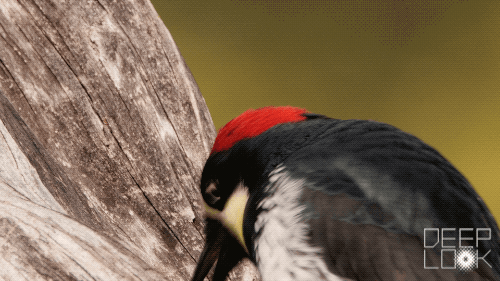
In the spring, acorn woodpeckers have their choice of food. They catch insects, eat oak flowers and suck the sap out of shallow holes on trees such as coast live oaks.
But in the winter, when these foods are unavailable, the birds feed on the acorns they stored in the late summer and fall. Acorns don’t have that much protein compared to insects, and they taste bitter, said Koenig. But the birds can stock up on them and keep them readily available in their granary.
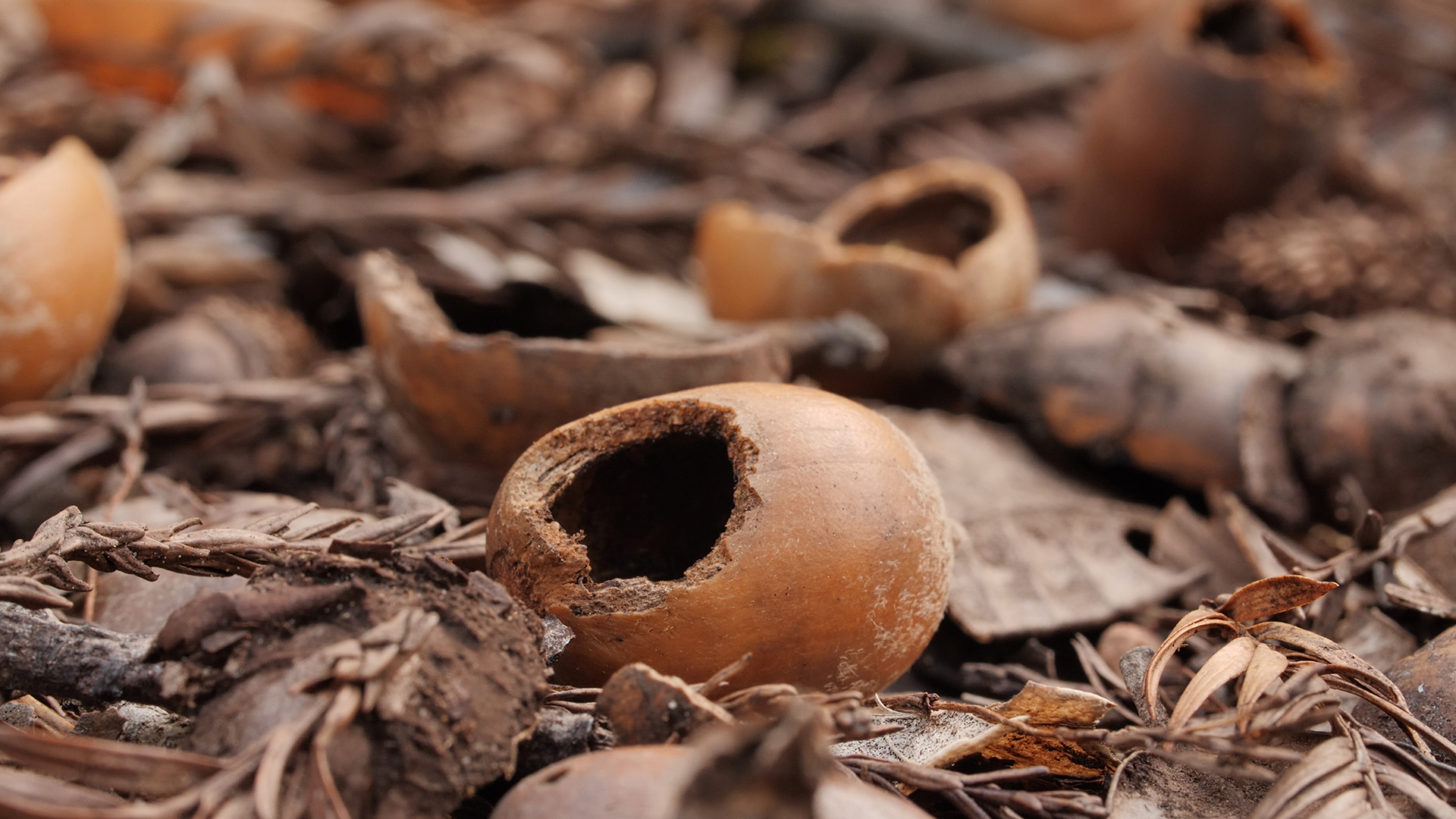
The birds need to keep the acorns snug in their holes so that other animals can’t pull them out. So they regularly move up and down the tree trunk, tapping the acorns into their holes as they go. If they find one that’s loose, they pull it out and move it to a smaller hole.
Acorn woodpeckers’ ability to reproduce in the spring depends on an abundant acorn crop the previous year. But oaks are finicky trees.
“Some years there are acorns all over the place,” said Koenig, “and other years there aren’t any acorns at all.” This is why acorn woodpeckers live where there are several species of oaks, he said, which increases the chances that they’ll have access to acorns.
Keeping a granary stocked takes a lot of work. So acorn woodpeckers live in family groups: four or five of them in something like a commune, with several males that are related to each other mating with several females that are related to each other but not to the males.
“There are only a handful of species in the world that are known to be similarly complex,” Koenig said.
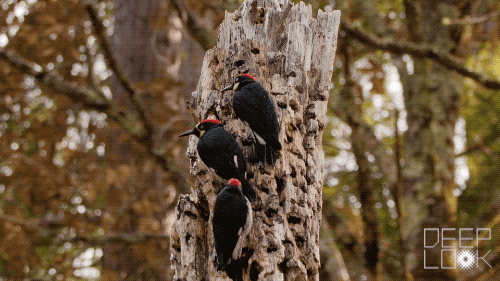
Young woodpeckers who aren’t yet old enough to mate help take care of the chicks when they’re born in the summer.
“It’s wonderful to see several birds lined up under a nest cavity to feed the nestlings,” Marianchild said. “It’s proof of cooperative breeding.”
When a member of the group dies, young woodpeckers from other groups audition to join the group, in hopes of being able to start mating. These power struggles are loud and can last days.
“You get birds chasing each other, yelling and screaming at each other, grappling,” said Koenig. “They’re incredibly exciting.”
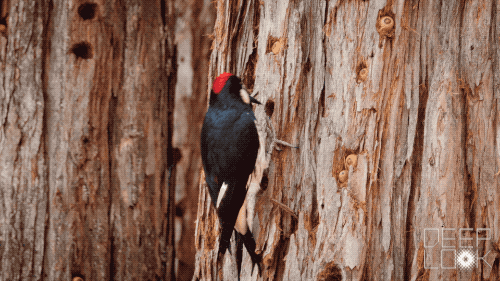
A group drills a few new holes each year. Every member works on the granary, and the acorns belong to all of them. Granaries can have thousands of holes and be built and maintained over many generations.
When one of the birds wants to eat an acorn, it sometimes pecks it open right in the hole where it’s stored. Or it might carry the acorn to a nearby tree and wedge it in a nook before cracking it open by pounding on it.
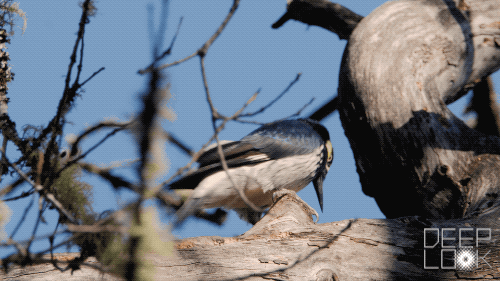
Agriculture and urbanization in some places have reduced the oaks that are available to the birds and put humans in closer proximity to them. On occasion, acorn woodpeckers drill holes into telephone poles and the wood trim of houses.
“People can discourage them from pecking holes in their houses,” said Marianchild. “They can put up bird netting or hang shiny things. Or they can build houses out of stucco rather than wood.”
At the Marin Municipal Water District’s offices in Fairfax, which are surrounded by oaks, acorn woodpeckers stuff their supplies into the eaves, said Janet Klein, natural resources program manager. To protect the ranger station, they’ve put up a secondary layer of pine to give the woodpeckers something to drill into. Despite the noise, Klein enjoys watching them at work.
“You can watch the woodpeckers try out different holes,” she said. “‘Too tight, too loose.’”